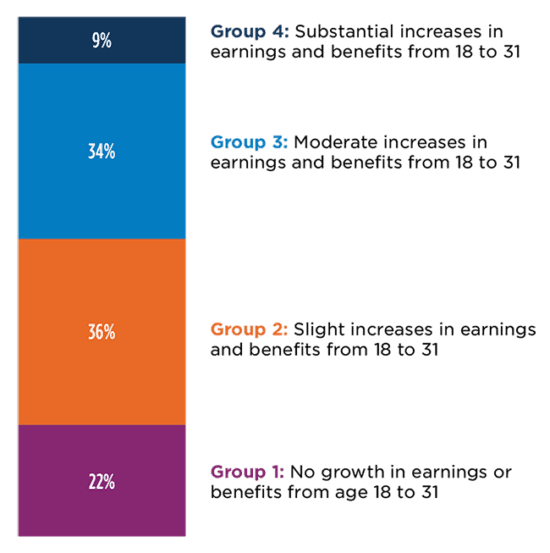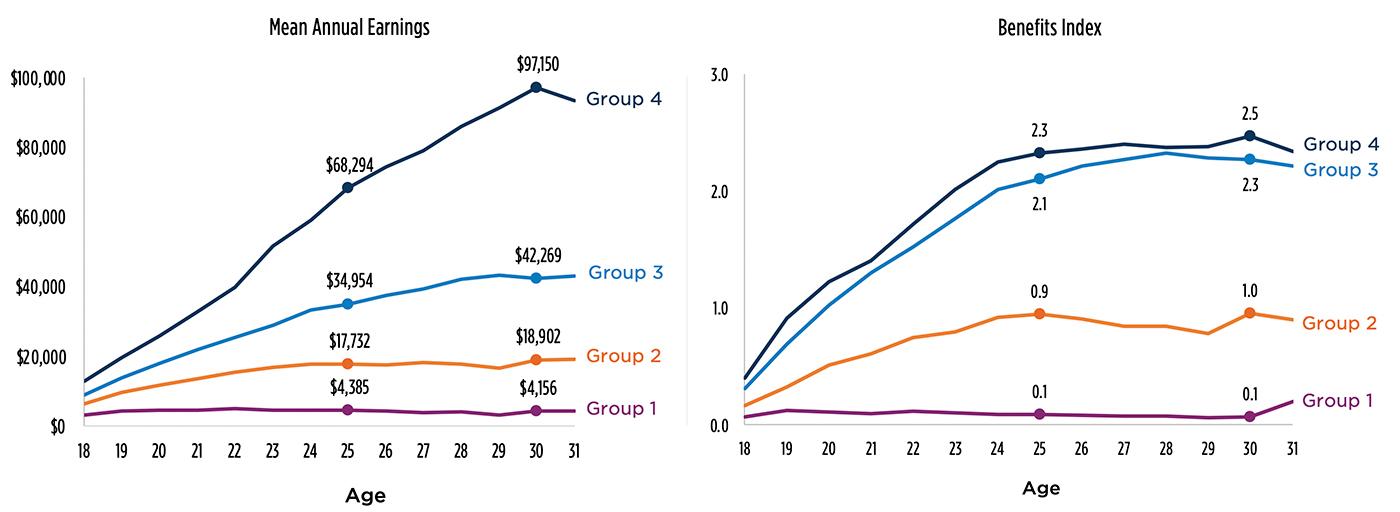Understanding Employment Trajectories for Socioeconomically Disadvantaged Young Adults Can Support Their Well-being
Early adulthood is a critical life stage for education, employment, relationship formation, and reproductive health, but young adults’ experiences in these areas are highly varied. Using averages to describe youths’ experiences may miss meaningful differences that could alter their developmental trajectories. Understanding these trajectories—and their implications for youth of varying races, ethnicities, and genders—can help researchers, practitioners, and policymakers support young people’s development and ensure greater well-being into their adulthoods.
This brief summarizes some findings from a new report by Child Trends and the Brookings Institution that reveals different employment pathways taken by young adults from disadvantaged backgrounds through the use of trajectory analysis—a person-based approach that allows us to cluster people into meaningful patterns based on their employment earnings and the fringe benefits they receive. For our application of trajectory analysis, we started with a sample of youth who experienced socioeconomic disadvantage in adolescence, defined as those who met at least one of the following four criteria: lived in a low-income family, had no parent with a post-secondary degree, had a mother age 19 or younger at her first childbirth, or had a family that received public assistance. After identifying an initial sample, we followed these young adults from age 18 to 31 and clustered them into groups that follow a similar pattern. (For more information about our methods, see the Data and methods section at the end of this brief.)
Findings
We found four divergent employment pathways, or trajectories, that distinguish these young adults’ earnings and benefits patterns from age 18 to 31. Each trajectory represents a group of youth with strikingly different employment paths: In Group 1 (the lowest earnings group, representing 22% of the sample), young adults experienced essentially no growth in earnings or benefits from age 18 to 31; Group 2 (36% of the sample) experienced only slight increases by age 31 and Group 3 (34% percent) experienced moderate increases. Only Group 4 (9% of the sample) experienced substantial growth in earnings and benefits by age 31. Figure 1 shows the relative sizes of each group within our overall sample.
Figure 1: Percentage of Adults Who Experienced Adolescent Disadvantage Placed in Each Trajectory Group

Figure 2, below, shows how each trajectory grouping fares over time on earnings and benefits. The benefits portion of the figure shows groups’ performance on the benefits index, which measures the average number of benefits received by youth in each group from age 18 to 31. The mean annual earnings portion of the figure shows the average yearly earnings in 2019 dollars for each trajectory group in the same age interval.
Figure 2: Earnings and Benefit Trajectories from Age 18 to 31 Among Young Adults from Disadvantaged Backgrounds

Note
The four trajectories also illustrate racial and ethnic disparities in employment pathways that are reflective of persistent inequities within labor markets, the criminal justice system, and broader income disparities:
- White people and men are overrepresented in the two highest-earning trajectory groups, while Black people and women are overrepresented in the lowest-earning group. White people make up more than half of the study population (58%); while they account for half of the adults in Groups 1 and 2, they make up 63 percent of Group 3 and 71 percent of Group 4.
- Black people are overrepresented in Group 1 (31%) relative to their share of the study population (20%) and underrepresented in Group 3 (14%) and Group 4 (9%).
- Latino or Hispanic people appear in most groups roughly proportionally to their share of the study population (17%), although they are somewhat underrepresented in Group 4 (14%).
We also used multivariate analysis to identify factors that predict membership in each trajectory group (including variables such as education, demographics, and job characteristics) and found that:
- Youth with union membership and job training in their 20s are more likely to be in one of the highest-earning groups (Groups 3 and 4), while youth with higher education and military experience are more likely to be in the second-highest-earning group (Group 3).
- Incarceration, work-limiting health conditions, or prolonged unemployment are strongly associated with lower-earning trajectories (Groups 1 and 2).
- Being female and being Black greatly increases the probability of being in a trajectory group with low economic mobility, even after controlling for other factors.
Finally, to better understand how trajectories differed by race and gender, we replicated the same trajectory analysis among subsamples of Black youth only, Hispanic youth only, White youth only, women only, and men only. In each analysis, we again found four distinctive patterns; however, the levels of earnings attained by each subpopulation were very different: White and male youth experienced substantially greater increases in their earnings over their 20s and moderately larger increases in the benefits associated with their work.
- At age 30, White youth in the highest-earning group attained earnings of $108,500, compared with $64,900 for Black youth and $69,900 for Hispanic youth in their respective high earnings groups (in 2019 dollars).
- For the subpopulation of men, the highest-earning trajectory group earned $104,700 by age 30, compared with $75,100 for the highest-earning trajectory group among the subpopulation of women.
Related Content
- Integrating Positive Youth Development and Racial Equity, Inclusion, and Belonging Approaches Across the Child Welfare and Justice Systems
- Simulation Results Suggest That Improving School Readiness May Yield Long-term Education and Earnings Benefits
- Supporting Young Parenting Students With Navigation Services
Conclusion
This analysis of earnings growth during the early adulthood years highlights the presence of significant barriers to upward mobility for young people with socioeconomic disadvantages, as well as persistent systemic inequities for Black and Hispanic youth and young women. Research suggests that these inequities also compound: For example, women of color suffer from both gender and race discrimination, and experience significant wage gaps when compared to white men.
Research findings have long pointed to reforms that can offer young people better options. Due to systemic inequities within public education systems, reforming education to better help young people complete high school—and prepare them for postsecondary education—can help safeguard youth from severe economic deprivation. The nation’s criminal justice system also needs an overhaul to address the disproportionate incarceration of Black men; this analysis illustrates how incarceration doesn’t simply limit opportunities for upward mobility, but places obstacles in the way of youth that keep them trapped in poverty. Further, communities can provide youth who face socioeconomic disadvantages with new opportunities: Job training for youth in their early 20s may give them a strong push toward economic health and self-sufficiency.
Data and Methods
Suggested citation
Piña, G., Moore, K. A., & Warren, J. (2022). Understanding employment trajectories for socioeconomically disadvantaged young adults can support their well-being. Child Trends. https://doi.org/10.56417/9027u5978f
© Copyright 2024 ChildTrendsPrivacy Statement
Newsletter SignupLinkedInThreadsYouTube